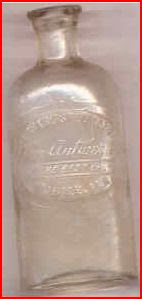 Artifacts Found in Caribbean.
Artifacts Found in Caribbean.The item on the left is obviously a musket ball, but I have been trying to identify the other item for quite some time without any success at all. Just yesterday, though, I found a web site that shows a very similar item that was from a shipwreck of the late 18th century, which is about the same time period that a famous Naval battle was fought near the island where the item was found.
I found the similar looking item on a great webs site for viewing shipwreck artifacts. The web site shows artifacts from the HMS Sirius, which was built in 1780 and wrecked in 1790.
The HMS Sirius was commissioned as a store ship and therefore carried a lot of unused items, including those for ship repair.
Here is the gallery of artifacts. There are a lot of different items to look at but if you scroll down you'll come to what are called roves.
http://www.hmssirius.com.au/recovery/artefacts
The roves shown by that web site are the closest thing that I've seen to my mystery item. At this point, I feel that the mystery item could well be a rove. There were a number of them found at the same location on the Caribbean Island and were associated with other items such as the musket ball.
Here is a web site that shows how roves are used.
http://www.faeringdesigninc.com/instruct.html
You might also want to back up and learn more about the Sirius. Here is the link for that.
http://www.hmssirius.com.au/flagship-of-the-first-fleet
I doubt you are all that interested in roves, but it shows how you can study an item for a long time (several years in my case) before finally figuring out what it might be. That is why I recommend holding onto items until you know what they are.
I also hope you enjoyed looking at the other artifacts shown on that web site. It is always good to improve your knowledge of artifacts. You never know what you might find on a beach.
Forecast and Conditions.
 From what I saw this morning I can't rate the Treasure Coast treasure beach conditions any better than a 1 (poor).
From what I saw this morning I can't rate the Treasure Coast treasure beach conditions any better than a 1 (poor). As you can see from this first beach photo, I did find a little scalloping going on, and expect that to increase a little at high tide today.
Nothing exciting, but at least there is some sand moving.
Maybe some of the other beaches are better. I doubt it though, because the water didn't get very high on the beach and the waves seem to be hitting almost directly out of the East while the wind is out of the south/southeast.
The beach photo below shows how wide the low tide area is. There is a lot of sand out in front of the beach to protect the beach.

It doesn't look like the beach will change much in the next few days.
Happy hunting,
TreasureGuide@comcast.net
















































